by Eric Stewart
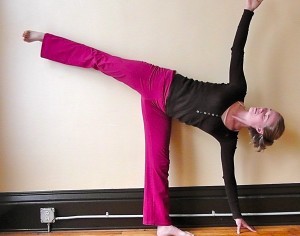 The students in the course I teach at Oberlin College have advanced to the point where we’ve begun learning half-moon pose (ardha chandrasana). This is one of the most difficult standing poses, especially because it involves balance on one leg.
The students in the course I teach at Oberlin College have advanced to the point where we’ve begun learning half-moon pose (ardha chandrasana). This is one of the most difficult standing poses, especially because it involves balance on one leg.
I introduce half-moon using the support of blocks, sometimes a chair, and sometimes the wall. These supports make it easier to learn how to distribute weight and elongate limbs, so that balance over the standing leg becomes clearer.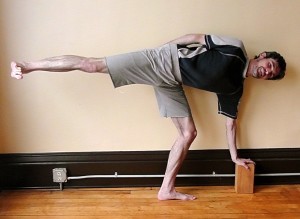
As I observed people tentatively begin to unfold into the asana, the usefulness of the support was apparent. I also noticed how some students tended to over-rely on the block or the wall, which caused them to remain in an unbalanced, restricted state. If the support was removed, these students would be unable to maintain the pose. They would fall out quicker than you could say yoga (or any other two syllable word).
Support, in an asana and in life is a precious thing. Whether it is the support of the earth and the air we breathe, or the support of friends, family or coworkers, any action depends upon assistance that is beyond the capacity of a single person to provide for themselves. Yoga is a fantastic practice for learning this.
Also precious is the ability to assess how support is utilized. While support is a necessity, its utilization can be more or less effective. Support used well translates into grace and ease. On the other hand, a person can relate to support in ways that actually hinder learning and development.
Balance poses can serve as a great opportunity for people to explore both the necessity of support and also how to best use it.
In the class, we moved away from the relative security of the wall and began practicing half-moon in the middle of the room. While sustained balance on one leg was more difficult here, the challenge offered students an opportunity to learn directly from the physical sensation of being in or out of equilibrium.
Initially, many more students fell out of the pose. At this point I offered them some suggestions about how to distribute weight into the grounded foot and how to keep the standing leg steady. I also had a more general suggestion for them, and this is what I want to relate here, more than the technical details of doing the asana:
Falling: a Great Teacher
When you fall out of a balance pose (or even when you start to feel unstable) it’s easy to feel that falling is what you are not supposed to do. When this happens, the tendency is to brace and tighten more, which often leads to further loss of balance.
Instead, your greatest resource for finding balance is the internal sense you have of your body in space: the moment to moment sensations that alert you to your physical orientation. It can take some practice to learn to interpret this information with accuracy. Sometimes part of this learning process involves falling.
As an advocate of the educational benefits of falling, I’ll clarify that it is important to be intelligent about the falling you do. For instance, it is foolish to attempt an asana that you are not ready to do, where the likelihood of falling and hurting yourself is great.
On the other hand, it is intelligent to provide yourself with smaller challenges that build from your current ability and capacity, opening that capacity further. If the challenge you set for yourself involves balance on one leg, falling is a distinct possibility. Yet, rather being a disruption of the learning process, falling contains essential information for the development of greater capacity.
This is where skillful use of support is so essential. For instance, if you attempt a balance pose over and over, and you keep falling out, it’s easy to become frustrated and stop doing the practice.
Another way to look at the situation is that the act of falling provides information about support. Falling (in the role of the teacher) is saying, “Find a simpler way to do what you\’re attempting, and consider finding more support to help you.” That support might consist of a chair, a block or the advice of a teacher, depending on the circumstances.
Being skillful also means avoiding over-reliance on otherwise helpful support. If a student uses props to eliminate the possibility of falling, they miss an essential vulnerability that opens to the experience of instability. Learning happens in that openness.
What I related to my students is that a balance pose like half-moon keeps the practitioner honest. On two feet, an asana is easier to fudge without immediate consequences. On one foot, the teacher otherwise known as instability informs the practitioner whether their asana has integrity or not. I encourage you to pay attention to this wise instructor!
Want to explore standing on one foot?
There are lots of ways, ranging from simple and easy to intricate and challenging.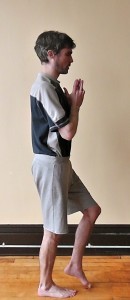
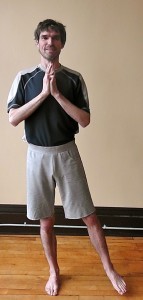 If standing on one leg is difficult for you, have a wall nearby, but challenge yourself by contacting the wall less and less. Or keep the big toe-tip of the lifted leg touching the floor. You can lift the leg in front of you, swing it out to the side, or extend it behind you.
If standing on one leg is difficult for you, have a wall nearby, but challenge yourself by contacting the wall less and less. Or keep the big toe-tip of the lifted leg touching the floor. You can lift the leg in front of you, swing it out to the side, or extend it behind you.
In the standing leg, the activity of the toes (especially the big toe) is very important for effective balance. A useful practice to prepare for balance on one leg is to lift your heels off the floor and balance on the forefoot and toes. Then lower the heels and lift your toes off the floor.
When you set the toes on the floor, lengthen them and then engage them with the floor. You can alternate between lifting heels/lifting toes/engaging toes for several cycles.
As you become comfortable balancing on one leg, you can increase the challenge by closing your eyes. First do this with the support of a wall nearby, or with the big toe-tip of the lifted leg on the floor. Again, you can test your integrity by relying less and less on the support of the wall or the floor.
These skills benefit from regular practice.
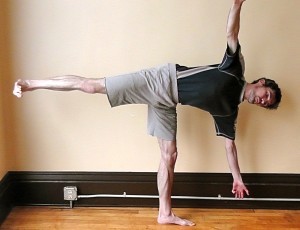 If ardha chandrasana is a familiar pose for you, consider testing yourself by taking the lower hand/fingers away from the floor or the block. Can you maintain your balance? Or try lifting the heel of the standing leg off the floor. Have fun!
If ardha chandrasana is a familiar pose for you, consider testing yourself by taking the lower hand/fingers away from the floor or the block. Can you maintain your balance? Or try lifting the heel of the standing leg off the floor. Have fun!
Happy practicing!